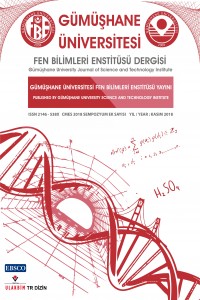Öz
The strength
of hamstring and quadriceps muscles plays an important role for athletes and
sportspeople in determining their performance. The purpose of this study is to
predict the hamstring and quadriceps muscle strength using Multiple Linear
Regression (MLR). The dataset used for this study includes the data of 70
athletes consisting of the features gender, sports branch, height, weight and
age, as well as the hamstring and quadriceps muscle strength values measured
with two types of activities (static training and classic training) used as the
target variables. MLR has been used for the development of prediction models
using different types of validation options including cross-validation and
random percentage data split. The Root Mean Square Error (RMSE) has been
utilized as the main error metric for evaluating the performance of the
prediction models. The RMSE values of the prediction models range between 14.91
and 32.41 Nm, showing that in addition to machine learning methods, MLR can
also be used for predicting the hamstring and quadriceps muscle strength with
acceptable error rates.
Anahtar Kelimeler
Kaynakça
- Akay, M.F., Abut, F., Çetin, E., Yarım, İ. and Sow, B. 2017. Support Vector Machines for Predicting the Hamstring and Quadriceps Muscle Strength of College-Aged Athletes. Turkish Journal of Electrical Engineering and Computer Sciences. 25, 2567-2582. Abadie, B. and Wentworth, M.C. 2000. Prediction of One Repetition Maximal Strength from a 5-10 Repetition Submaximal Strength Test in College-Aged Females. Journal of Exercise Physiology. 3, 1-6.
- Horvat, M., Ramsey, V., Franklin, C., Gavin, C., Palumbo, T. and Glass, L.A. 2003. A method for predicting maximal strength in collegiate women athletes. The Journal of Strength & Conditioning Research. 17, 324-328.
- Harbo, T., Brincks, J. and Andersen, H. 2012. Maximal isokinetic and isometric muscle strength of major muscle groups related to age, body mass, height, and sex in 178 healthy subjects. European Journal of Applied Physiology. 112, 267-275.
- Muraki, S., Fukumoto, K. and Fukuda, O. 2013. Prediction of the muscle strength by the muscle thickness and hardness using ultrasound muscle hardness meter. Springerplus. 2, 457.
- Sow, B., 2017. Prediction of Hamstring and Quadriceps Muscle Strength of Athletes Using Machine Learning Methods. Yüksek Lisans Tezi, Çukurova Üniversitesi Fen Bilimleri Enstitüsü.
Öz
Hamstring ve Kuadriseps kas
gruplarının gücü, atletler ve sporcuların performanslarının değerlendirilmesi
için önemli bir rol oynamaktadır. Bu çalışmanın amacı, Hamstring ve Kuadriseps
kas gücünün Çoklu Doğrusal Regresyon (Multiple Linear Regression, MLR)
kullanılarak tahmin edilmesidir. Bu çalışma için kullanılan veri seti 70
sporcuya ait cinsiyet, spor dalı, boy, ağırlık ve yaş bilgilerinin yanı sıra
hedef değişkenleri olarak iki tip fiziksel aktivite (statik antrenman ve klasik
antrenman) ile ölçülen hamstring ve kuadriseps kas gücü değerlerinden
oluşmaktadır. Tahmin modellerinin oluşturulmasında MLR ile birlikte çapraz
doğrulama ve rastgele veri dağılımı olmak üzere farklı doğrulama seçenekleri
kullanılmıştır. Tahmin modellerinin değerlendirilmesi amacıyla Ortalama Karesel
Hata (Root Mean Square Error, RMSE) değerleri hesaplanmıştır. RMSE
değerlerinin 14.91ve 32.41 Nm olarak değişmesi, MLR’nin kabul edilebilir hata
oranlarıyla, hamstring ve kuadriseps kas gücünün tahmininde makine öğrenme
yöntemlerine alternatif olarak kullanılabilirliğini göstermektedir.
Anahtar Kelimeler
Kaynakça
- Akay, M.F., Abut, F., Çetin, E., Yarım, İ. and Sow, B. 2017. Support Vector Machines for Predicting the Hamstring and Quadriceps Muscle Strength of College-Aged Athletes. Turkish Journal of Electrical Engineering and Computer Sciences. 25, 2567-2582. Abadie, B. and Wentworth, M.C. 2000. Prediction of One Repetition Maximal Strength from a 5-10 Repetition Submaximal Strength Test in College-Aged Females. Journal of Exercise Physiology. 3, 1-6.
- Horvat, M., Ramsey, V., Franklin, C., Gavin, C., Palumbo, T. and Glass, L.A. 2003. A method for predicting maximal strength in collegiate women athletes. The Journal of Strength & Conditioning Research. 17, 324-328.
- Harbo, T., Brincks, J. and Andersen, H. 2012. Maximal isokinetic and isometric muscle strength of major muscle groups related to age, body mass, height, and sex in 178 healthy subjects. European Journal of Applied Physiology. 112, 267-275.
- Muraki, S., Fukumoto, K. and Fukuda, O. 2013. Prediction of the muscle strength by the muscle thickness and hardness using ultrasound muscle hardness meter. Springerplus. 2, 457.
- Sow, B., 2017. Prediction of Hamstring and Quadriceps Muscle Strength of Athletes Using Machine Learning Methods. Yüksek Lisans Tezi, Çukurova Üniversitesi Fen Bilimleri Enstitüsü.
Ayrıntılar
| Birincil Dil | İngilizce |
|---|---|
| Konular | Mühendislik |
| Bölüm | Araştırma Makalesi |
| Yazarlar | |
| Yayımlanma Tarihi | 30 Kasım 2018 |
| Gönderilme Tarihi | 23 Haziran 2018 |
| Kabul Tarihi | 30 Kasım 2018 |
| Yayımlandığı Sayı | Yıl 2018 CMES 2018 Ek Sayısı |

